Korea, North, is a country in East Asia. It is one of two countries on the Korean Peninsula, which extends south from northeastern China. North Korea covers the northern half of the peninsula, and South Korea occupies the southern half.
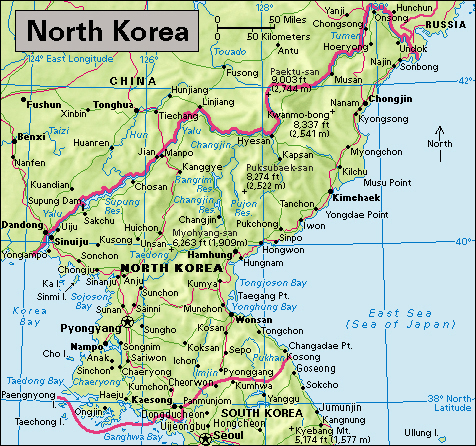
North Korea’s official name is the Democratic People’s Republic of Korea. Pyongyang is its capital and largest city. North Korea has a Communist government, and its Communist Party holds political power.
People probably have lived on the Korean Peninsula for at least 30,000 years. Various Korean and foreign governments ruled the peninsula from ancient times to the 1900’s. Korea was a colony of Japan from 1910 until World War II ended in 1945. After Japan’s defeat in the war, Korea was divided. Communists gained control of the North in 1945. The separate governments of North and South Korea were formed in 1948.
From 1950 to 1953, North and South Korea fought one another in the Korean War. But neither side won a complete victory, and a permanent peace treaty has never been signed. Since the war, small-scale clashes between North and South Korea have occasionally taken place.
Mountains cover about 80 percent of North Korea. Plains stretch along the western and northeastern coasts of the country. Most of the North Korean people live on the coastal plains or in river valleys.
Until the early 1900’s, the economy of what is now North Korea was based almost entirely on agriculture, and nearly all Koreans worked as farmers. Today, the economy of North Korea is dependent on heavy industry, and the government controls nearly all economic activity. North Korea’s economy is far less developed than that of South Korea.
Government
The North Korean Constitution says that political power belongs to the people. But the country’s Communist Party, called the Korean Workers’ Party, holds the real political power. The Constitution guarantees such rights as freedom of the press, religion, and speech. But the North Korean people have little freedom. The Communists maintain strict control over all aspects of life to ensure their dominance of the country.

National government.
The chairman of the State Affairs Commission is the head of state and North Korea’s most powerful official. The Politburo of the Central People’s Committee is the most powerful policymaking body. Officials of this body are high-ranking members of the Communist Party. They hold office on the committee because of their positions in the party.
North Korea’s legislature, called the Supreme People’s Assembly, has 687 members, elected by the people to five-year terms. The Constitution says the legislature is North Korea’s highest government authority. But it actually has little power. The Communist Party selects all legislative candidates, who run without opposition in each of the 687 districts. The legislature meets only once or twice a year and functions according to the wishes of the Communist Party.
Loading the player...North Korea national anthem
A cabinet is responsible for carrying out government policies. It is headed by a premier, who is appointed by the Supreme People’s Assembly. Its other members consist of the heads of government ministries and commissions, who are appointed by the Supreme People’s Assembly.
Local government.
North Korea has nine provinces. Four cities are directly governed by the national government—Kaesong, Nampo, Rason, and the capital city of Pyongyang.
Politics.
The Communist Party, also called the Korean Workers’ Party, is the ruling party of North Korea. The party makes the country’s laws, chooses all candidates for elections, and approves all people appointed to public office. Officially, North Korea has a number of other political parties. However, these parties may not oppose the policies of the Workers’ Party.
Courts.
The Central Court is North Korea’s highest court. Its justices are chosen by the Communist Party and elected by the Supreme People’s Assembly. Other courts in North Korea include provincial courts and people’s courts.
Armed forces.
North Korea’s military is one of the largest in the world. It consists of an army of more than 1 million active members, an air force, and a navy. Men and women are required to serve in the armed forces. Millions of people serve in the reserve forces. Members of local militias, which make up part of the country’s reserve forces, serve part-time.
People
Ancestry.
Ethnic Koreans make up almost the entire population of North Korea. A small minority of people are of Chinese descent.
Language.
Korean is the official language of North Korea. An unusual feature of the Korean language is that about half of all Korean words come from Chinese. Korean has about seven major dialects (local forms). Most North Koreans understand all the dialects. The Korean alphabet has 24 basic letters. It is called Choson’gul in North Korea and Han’gul (also spelled Hangeul) in South Korea. It was developed at the court of King Sejong in the 1440’s.
Way of life
Before the 1900’s, the people of what is now North Korea lived in an agricultural society built on strong family ties. Most Koreans lived in small villages and worked on farms. In many families, several generations lived together. The oldest male served as head of the family, and all people were expected to obey their elders. 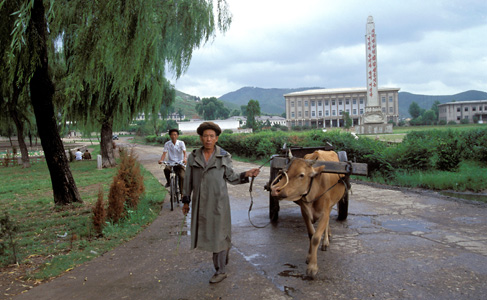
This way of life changed quickly after Japan seized control of the Korean Peninsula in 1910. The Japanese brought industry to Korean cities and took much farmland away from the farmers. They forcibly moved many young Koreans to the cities to work. The old way of life changed even more after Korea’s division into two countries in the 1940’s. In North Korea, the Communists took steps to make the country an industrial society.
City life.
Changes in North Korea since the 1950’s have led to a rapid increase in the proportion of people living in cities. Most city dwellers in North Korea work in factories. The majority of them live in one-room or two-room apartments built after Korea’s division. Few city people besides high-ranking government officials have houses.
Pyongyang is North Korea’s most modern city, with skyscrapers, broad boulevards, cultural centers, and sports stadiums. However, it has few restaurants or places of entertainment. Few North Koreans own automobiles. 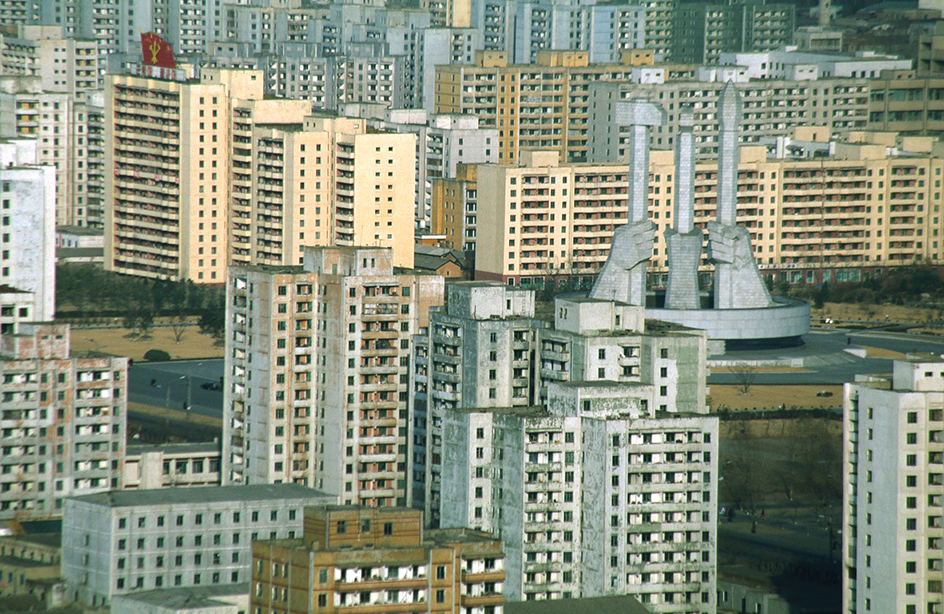
Rural life.
After the division of Korea, the Communists in the North built many apartments on collective farms in rural areas. Most North Korean farmers work on such farms, which are operated cooperatively by a large group of farmers. Much farming is done with modern machinery.
Clothing.
Most people in North Korea wear clothing like that worn in other Asian countries, Europe, and the Americas. However, many people wear traditional clothing for holidays and special occasions. Traditional clothing for women consists of a long, full skirt and a tight-fitting jacket. For men, traditional clothing consists of loose-fitting trousers, shirts, and jackets.
Food and drink.
Rice is the basic food of most North Koreans. Other common foods include barley; fish; such fruits as apples, peaches, pears, and melons; and such vegetables as beans, potatoes, and sweet potatoes. One of the most popular dishes other than rice is kimchi, a highly spiced mixture of pickled cabbage and radish. Consumption of meat and dairy products is small but increasing.
Tea is a traditional drink in North Korea, but many people drink coffee. Adults drink soju, a distilled alcoholic beverage usually made from grain, as well as ch’ongju, known in the West as sake or rice wine. In the rural areas, a home-brewed drink known as makkolli, made from rice, has also been popular. Young adults frequently drink beer.
Recreation.
Most forms of recreation and entertainment in North Korea are supported and controlled by the state. The government operates gymnasiums and promotes participation in organized sports programs. The cities have theaters for drama, opera, and motion pictures. Drama groups travel throughout the country to perform for workers in rural areas.
Religion.
The North Korean Constitution guarantees religious freedom. But the government discourages religion because it conflicts with the teachings of Communism. Virtually no religious activities occur openly in North Korea.
Traditionally, many Koreans have been followers of Confucianism, which is more a moral philosophy than a religion. It stresses the duties that people have toward one another. See Confucianism.
Education.
Since the late 1940’s, North Korea has made special efforts to improve its educational system. As a result, the number of North Koreans who can read and write increased from less than half of the adult population in the mid-1940’s to almost all of the adults today.
North Korea requires children to attend school for 12 years, including a year of preschool. The state pays all educational expenses. Students must work for the state during part of the summer.
Elementary school consists of grades 1 through 4, and senior middle school has grades 5 through 10. Students must have Communist Party approval to continue their education after senior middle school. Those who continue attend a two-year high school, a two-year general vocational school, or a three- or four-year technical school that provides training for engineering and scientific jobs. Students who finish high school or technical school may go to college immediately. Vocational school graduates must complete a year of special study before they enter college.
North Korea’s main university is Kim Il-sung University in Pyongyang. The country’s other universities and colleges generally offer training in a single area, such as agriculture, engineering, or medicine. The government provides night schools for adults, training schools in factories, and courses for workers to take by mail.
The arts.
Early Korean art developed under the influence of both Chinese art and the teachings of Buddhism and Confucianism. Popular themes included love of nature, respect for learning, and loyalty to the king. The most widely practiced art forms included music, poetry, pottery, sculpture, and painting. Loading the player...
Korean folk music
In North Korea today, the government controls the work of artists. The government prohibits works of art that conflict with Communist principles. It encourages artists to show support in their work for the policies of the Communist Party.
The land
North Korea covers the northern part of the Korean Peninsula. A 487-square-mile (1,262-square-kilometer) demilitarized (neutral) zone separates North Korea from South Korea. North Korea shares most of its northern border with China. A small stretch of its northeastern border is shared with Russia. The East Sea, also called the Sea of Japan, lies east of North Korea and separates the country from Japan. The Korea Bay, part of the Yellow Sea, lies west of North Korea.
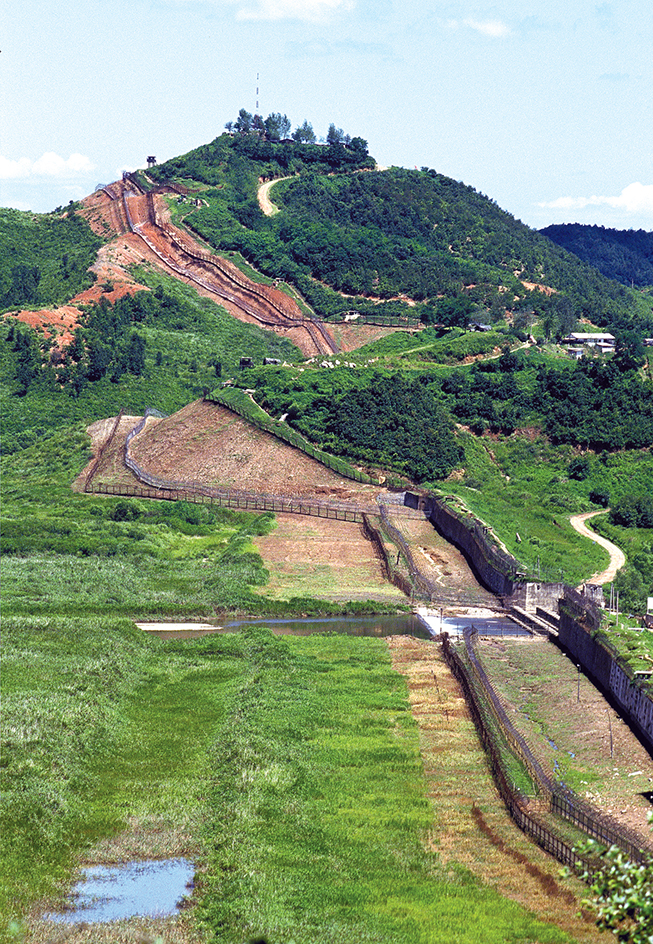
Rolling hills divide western North Korea into a series of broad, level plains. This region includes most of North Korea’s farmland and its major industrial area, including Pyongyang. About half the North Korean people live in the western plains region.
Forested mountains cover almost all of central North Korea. These mountains are an important source of valuable minerals and forest products. North Korea’s highest mountain, Paektu-san (Paektu Mountain), rises 9,003 feet (2,744 meters) on the border with China. North Korea’s longest river, the Yalu, flows westward from this mountain along the border for 490 miles (789 kilometers) to the Yellow Sea. The Tumen (also spelled Tuman) River forms the border eastward from Paektu-san to the East Sea (Sea of Japan). Almost a fourth of North Korea’s people live in the central mountain region.
The strip of land along North Korea’s east coast consists of a series of narrow plains separated by low hills. The plains provide much farmland, and fishing also is important in this region. The region also has some industrial areas. More than a fourth of North Korea’s people live in the eastern lowland region.
Climate
Seasonal winds called monsoons affect North Korea’s weather throughout the year. A monsoon blows in from the south and southeast during the summer, bringing hot, humid weather. A cold, dry monsoon blows in from the north and northwest during the winter, bringing cold weather.
July temperatures in North Korea average between 70 and 80 °F (21 and 27 °C). North Korea’s massive mountains protect the east coast from the winter monsoon. As a result, the east coast generally has warmer winters than does the rest of the country. Average January temperatures are about –5 °F (–21 °C) in parts of the central mountains and about 18 °F (–9 °C) in Pyongyang.
Precipitation (rain, melted snow, and other forms of moisture) averages from 30 to 60 inches (76 to 150 centimeters) a year in most of North Korea. Heavy rainfall from June through August accounts for about half of the yearly precipitation. In most years, one or two typhoons hit the Korean Peninsula during July and August.
Economy

Before the Korean War (1950-1953), the economy of North Korea depended chiefly on agriculture, though there was some heavy industry. After the war, the country’s economy grew rapidly. Industrial production, especially manufacturing, gained much importance.
In the 1970’s, North Korea’s economy began to decline. Rising debts, frequent droughts, mismanagement, and other factors have kept the country’s economy from recovering. Today, North Korea’s economy remains dependent on heavy industry. Its technology and economic production lag far behind that of South Korea.
Service industries
are economic activities that provide services rather than produce goods. Service industries account for about one-third of North Korea’s gross domestic product (GDP)—the total value of all goods and services produced within the country in a year. The government controls most of North Korea’s economy. As a result, government services is the leading service industry group.
Manufacturing and mining.
North Korea’s chief manufactured products include chemicals, clothing, machinery, metals, military products, processed foods, and textiles. The government owns nearly all North Korean factories, and it tightly controls all industry. Mining is important to the country’s economy. North Korean mines yield coal, copper, graphite, iron ore, lead, limestone, magnesite, salt, silver, tungsten, and zinc. 
Agriculture and fishing.
Agriculture accounts for about one-fifth of North Korea’s GDP and employs about one-fifth of its workers. Despite this, the country suffers from food shortages from time to time and must rely on international food aid.
The government controls most of North Korea’s farms. Most farms are collective farms, known in North Korea as cooperatives. Workers on these farms receive a share of the products and some cash payment. They may also help manage the farms. A few farms, called state farms, are owned and managed completely by the government. The workers on state farms receive wages.
The western plains have most of North Korea’s agriculture. Rice is by far the chief crop. Other major crops include apples, beans, cabbages, corn, potatoes, soybeans, and sweet potatoes. Farmers also raise cattle, chickens, and hogs.
North Korea’s fishing industry centers on its eastern coast. The catch includes pollock, shellfish, and squid. Fishing cooperatives operate on both coasts.
International trade.
North Korea imports more than it exports. The country’s chief trading partners include China, India, South Korea, and Thailand. North Korea’s leading exports include clothing, electronics, fish products, machinery, mined products, and textiles. Its major imports include cars and trucks, electrical equipment, food, machinery, petroleum, and textiles.
Energy sources.
Most of North Korea’s energy is produced by coal-burning plants and hydroelectric plants. Much of the rest of the country’s energy comes from imported petroleum.
Transportation.
Railroads carry most of North Korea’s long-distance freight and passenger traffic. North Korea has a limited road system, and most of the country’s roads are unpaved. Buses operate in the cities and for short distances in rural areas. Almost all cars are government-owned and are intended for official business use. Sunan, just north of Pyongyang, has an international airport. North Korea operates an airline, Air Koryo. The state runs the entire transportation system.
Communication.
The government controls all broadcasting, publishing, and other means of communication in North Korea. It runs North Korea’s radio and TV network and its broadcasting stations in the provinces. Radios and television sets can only be tuned to government programming. Internet use is restricted.
History
Early years.
Scientists have evidence that people lived in the southwestern part of the Korean Peninsula about 30,000 years ago. Much later, the ancestors of today’s Koreans arrived in the peninsula from the north. Scholars do not know for sure when this migration occurred, but it may have been about 5,000 years ago.
In 2333 B.C., according to tradition, the first Korean state developed along the Daedong River (also called Taedong River), near present-day Pyongyang. It was called Joseon (or Choson). In 108 B.C., China conquered the northern half of the peninsula and established four territories there. Korean tribes won back three of the territories by 75 B.C. The other territory, called Lelang, remained under Chinese control.
During the last century B.C., several Korean tribes united and formed the state of Goguryeo (or Koguryo) in the northeastern part of the peninsula. Two other Korean states—Baekje (or Paekche) in the southwest and Silla in the southeast—were formed at about the same time. Historians call Goguryeo, Baekje, and Silla the Three Kingdoms. 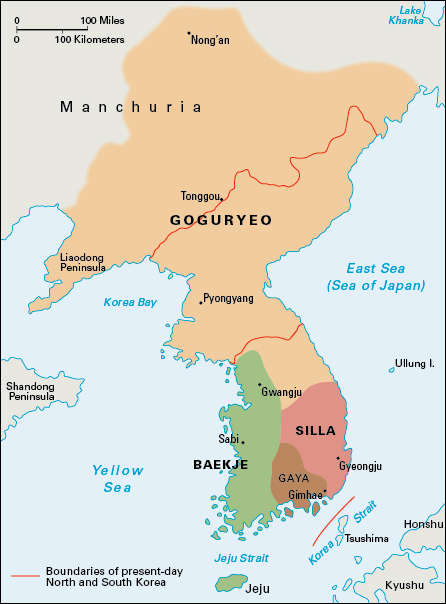
In 313, Goguryeo conquered Lelang and took control of the northern half of Korea. Buddhism, which the Koreans had learned about from the Chinese, became the chief religion of the Three Kingdoms in the 300’s and 400’s. In the 500’s and 600’s, wars raged among the Three Kingdoms for control of Korea. With the help of the Chinese Tang dynasty, Silla conquered Baekje and Goguryeo in the 660’s and took control of most of the peninsula. (A dynasty is a line of rulers belonging to the same family.) Korean art and learning flourished during the next 200 years. Confucianism, introduced into the peninsula from China, became a strong influence on Korean thought and behavior.
In the 800’s, Silla broke apart as the kingdom lost control over former Goguryeo and Baekje territories to rebel leaders. But by 935, a general named Wang Geon (also called Wang Kon) had conquered Silla and the surrounding states and renamed the area Goryeo (or Koryo). The name Korea comes from Goryeo. The government of Goryeo built schools and encouraged the development of printing to make more books available. The Koreans invented the first movable metal printing type in 1234. 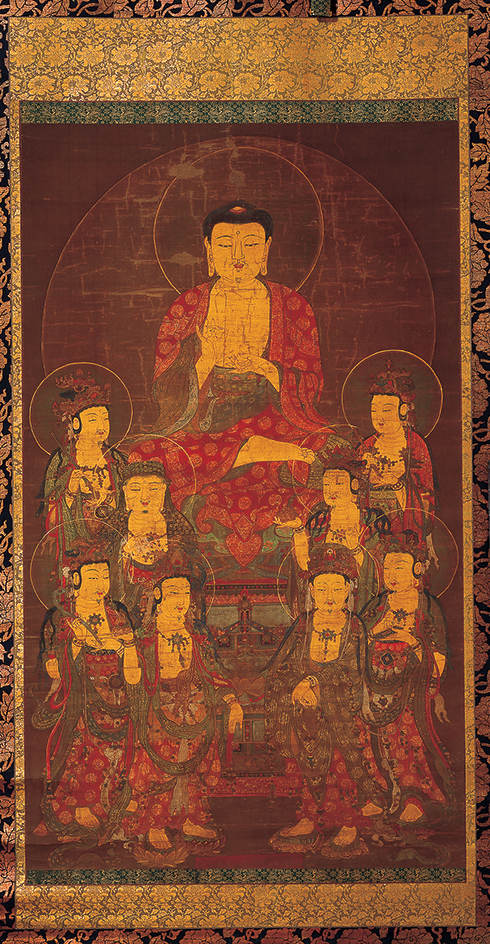
Mongol tribes from the north repeatedly attacked Goryeo from the early 1230’s until they conquered it in 1259. Goryeo regained its freedom in 1368 when the Ming dynasty rose to power in China. Two groups, one allied with the Mongols, the other with the Ming dynasty, fought for control of Goryeo. In 1388, a general named Yi Seonggye led the Ming-allied group to victory.
The Joseon dynasty.
General Yi became king of Goryeo in 1392 and renamed the country Joseon (or Choson). Today, Choson is one of the names North Koreans use for their country. South Koreans call their country Daehanminguk, often shortened to Hanguk.
Yi founded a dynasty called the Joseon (or Choson) dynasty (also known as the Yi dynasty). The dynasty lasted until 1910. Yi made Confucianism the national philosophy and ended the government’s official support of Buddhism that had existed since the 700’s. Buddhism declined in importance and did not become popular in Korea again until the 1900’s.
Yi and the rulers who followed him reunited Korea, reorganized the government, and promoted the arts. In the 1400’s, they regained lost territory and established the northern boundaries of what is now North Korea. But during the 1500’s, government officials and wealthy landowners began to struggle for political power. This struggle weakened Korea’s government.
Japanese forces invaded Korea in the 1590’s but were driven out with the assistance of Chinese forces. Manchu armies from the north invaded in the 1630’s. The Manchus forced Koreans to submit tributes (payments), but members of the Yi family continued as kings.
In the 1600’s, Korea’s rulers closed the country to all foreigners except Chinese and Japanese. The closure continued for almost 200 years. Korea was called the Hermit Kingdom during this period. Roman Catholicism came to Korea from China in the 1780’s. Catholic missionaries from Europe first arrived during the 1830’s. But Korean authorities persecuted the missionaries and killed thousands of Koreans who had become Catholics.
Korea under Japan.
In 1876, Japan forced Korea to open some ports to trade. Soon thereafter, the United States, Russia, and several European nations signed commercial treaties with Korea. An intense rivalry began over control of Korea. Japan defeated China in the Sino-Japanese War of 1894-1895, and Japan’s influence in Korea became stronger than China’s. Japan’s victory over Russia in the Russo-Japanese War (1904-1905) forced Russia to recognize Japan’s superior influence in Korea. Japan took complete control of Korea in 1910.
The Japanese governed Korea as a colony to benefit their own interests. During the 1930’s, the Japanese built many heavy industries in Korea to supply Japan with chemicals, iron and steel, machinery, and other goods. In the 1940’s, the Japanese forced the Koreans to take Japanese-style names, and they banned the use of the Korean language in public. Many Koreans were forced to aid the Japanese war effort during World War II (1939-1945). Some were sent to work in mines and factories inside and outside Korea. Others were drafted into the Japanese military. Some Korean women were forced to work as prostitutes for the Japanese armed forces.
A divided peninsula.
Korea remained under Japanese control until 1945, when Japan was defeated in World War II. After Japan’s defeat, United States troops occupied the southern half of Korea, and forces of the Soviet Union occupied the northern half. The United States and the Soviet Union tried to develop a plan for reuniting Korea. They failed, and the United States submitted the problem to the United Nations (UN) in 1947.
The UN wanted to supervise elections to choose one government for Korea. But the Soviet Union refused to allow UN representatives into the North. In the South, the Republic of Korea was formed on Aug. 15, 1948, under a government consisting of elected officials. In the North, the Communists announced the formation of the Democratic People’s Republic of Korea on Sept. 9, 1948. Kim Il-sung became North Korea’s leader. Both governments claimed to represent all of Korea.
In December 1948, the Soviet Union announced that all its troops had left North Korea. The United States withdrew its last troops from South Korea in mid-1949.
North Korean troops invaded the South in June 1950, and the Korean War began. The fighting continued until an armistice was signed in July 1953. Neither side won complete victory. The war involved not only the two Koreas, but also the most powerful Communist and non-Communist nations. The non-Communist nations fought under UN supervision. See Korean War. 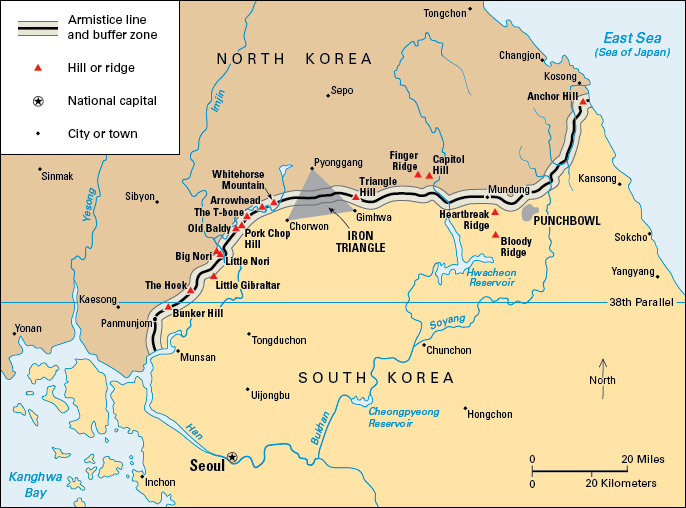
Communism in North Korea.
In 1946, when North Korea was still under Soviet occupation, the Communist government took over farmland from wealthy landowners and gave it to farmers living in poverty. The government also took control of most industries. Between 1953 and 1956, Kim Il-sung’s government organized all farmland into collective farms. In 1954, it announced the first of a series of plans for economic development, all emphasizing heavy industry. North Korea also built up its military power. Kim’s government operated as a strict dictatorship. Kim remained in power until his death in 1994.
North-South relations.
After the Korean War ended in 1953, the two sides remained hostile and suspicious of each other. In 1967, North Korean forces began making attacks in the Demilitarized Zone (DMZ) and into South Korea. The DMZ is the neutral area between the North and the South. In 1968, about 30 North Korean troops raided Seoul in South Korea. They tried to assassinate South Korean President Park Chung-hee but failed.
In January 1968, North Korea seized the U.S. intelligence ship Pueblo in the East Sea (Sea of Japan). In 1969, North Korea shot down a U.S. Navy plane almost 100 miles (160 kilometers) off the North Korean coast.
In 1971, representatives of North and South Korea began formal reunification discussions for the first time since the Korean War. Tensions between the two remained high, however. In 1983, a bomb blast killed 17 South Koreans, including four cabinet ministers, during an official visit to Rangoon, Burma (now Yangon, Myanmar). A court in Burma found North Korean agents guilty of the bombing. In September and October 1988, South Korea hosted the Summer Olympics. North Korea refused to participate after its request to be named co-host was denied.
In 1991, the two governments agreed to accept each other’s existence, and North and South Korea joined the UN as separate states. Also in 1991, talks resulted in several agreements, including a pact in which the two Koreas agreed not to use force against each other. As part of the pact, the two governments also agreed to increase trade and communication—which had been restricted—between them. Another accord prohibited North and South Korea from using or possessing nuclear weapons.
Nuclear tensions.
A crisis threatened to develop in 1994, when North Korea refused to allow international inspections of its nuclear sites. But North Korea signed a broad agreement with the United States promising to halt all nuclear weapons-related activities in return for energy assistance.
North Korea began experiencing severe food shortages in the mid-1990’s. Floods and drought destroyed crops. Experts estimate that hundreds of thousands of North Koreans starved to death. Food aid from around the world began arriving in the late 1990’s. 
After Kim Il-sung died in 1994, a struggle for power began. In 1998, North Korea’s government proclaimed the deceased Kim Il-sung “eternal president.” It then decreed that the head of the National Defense Commission would act as the country’s highest living official. Kim Jong-il, Kim Il-sung’s son, held this position and thus officially became North Korea’s leader.
In 2000, Kim Jong-il met face-to-face in Pyongyang with South Korean President Kim Dae-jung to discuss relations. It was the first meeting between the leaders of North and South Korea since the peninsula was divided. As a result of this meeting, the two countries have made some additional moves toward improving relations. For example, some North Korean and South Korean relatives have been allowed to visit one another, and road and rail links have been reestablished between the two countries. 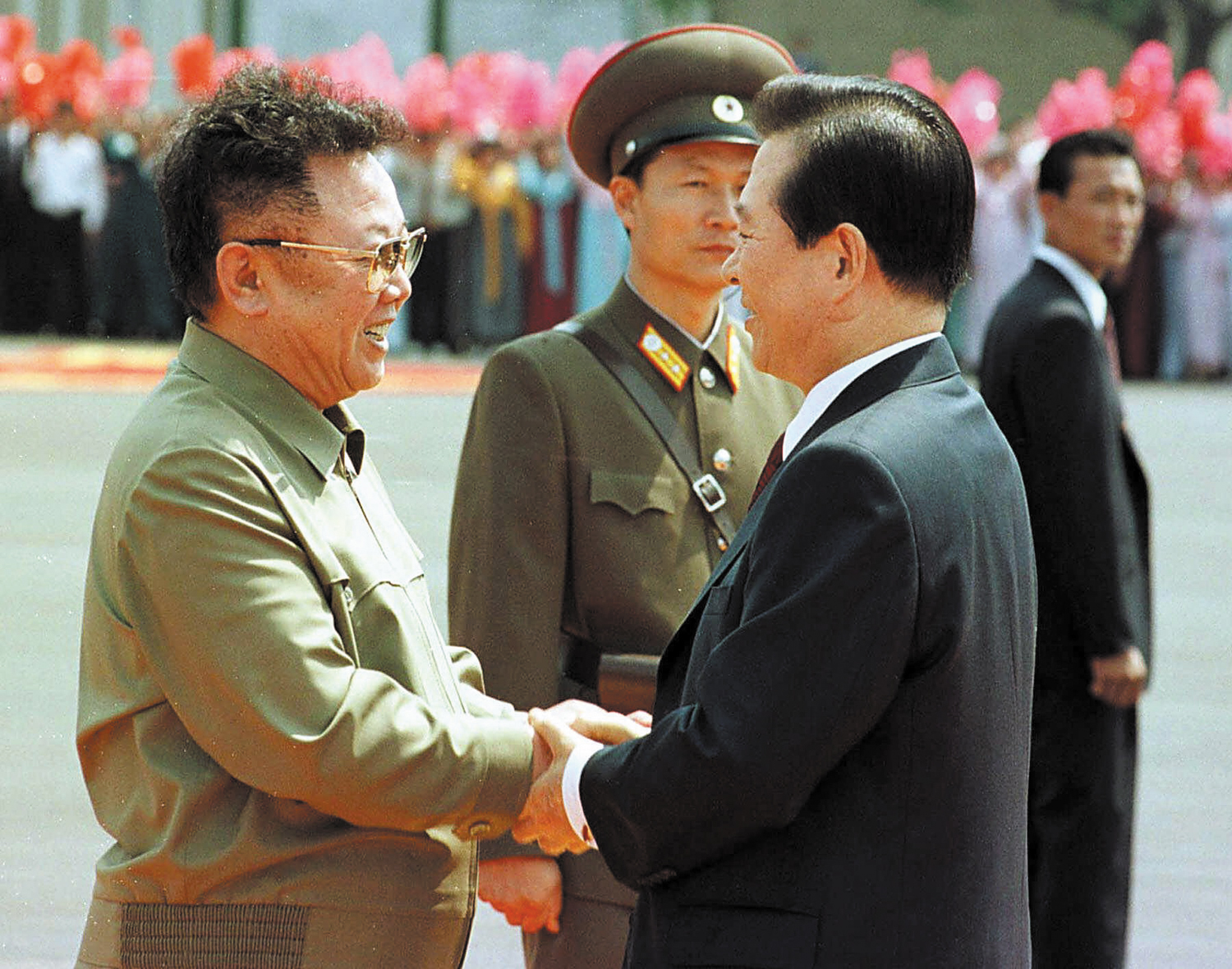
In 2002, North Korea held talks with Japan, the United States, and other countries in efforts to establish friendlier relations. However, these efforts were thrown into disarray when North Korea revealed that it had a secret program to develop nuclear weapons. The program violated North Korea’s 1994 agreement with the United States. In late 2002 and early 2003, North Korea expelled international atomic energy inspectors from the country and reactivated its nuclear facilities. In 2006, the country tested a nuclear device, though experts believed the device was small. The test caused the United Nations to impose economic sanctions on North Korea.
In 2007, international talks resumed. North Korea agreed to shut down its main nuclear reactor and take steps toward dismantling its nuclear weapons program in return for fuel assistance. International atomic energy inspectors announced in July of that year that the reactor had been shut down, but the country failed to meet a December 31 deadline to provide full details of its nuclear program. In May 2008, the North Korean government turned over thousands of pages of documents relating to its nuclear program to U.S. inspectors. However, the U.S. government had not removed North Korea from its list of countries suspected of sponsoring terrorism, which had been a condition of the agreement. In September, North Korea began to restart the nuclear work it had halted. The United States removed the nation from its list in October, and North Korea again halted its nuclear work and allowed international inspectors to visit its reactor sites.
In April 2009, North Korea tested a rocket that government officials claimed was intended to launch a satellite into orbit. However, some international affairs experts worried that it was actually a long-range missile test. The launch sparked international concern, and North Korea’s government again expelled inspectors from its nuclear sites. North Korea refused to continue international talks on its nuclear program and announced that it had restarted its main nuclear reactor. In May, the country conducted further nuclear and missile tests.
Recent developments.
In mid-2009, North Korea made steps to ease international tensions. Earlier in the year, the country had detained two journalists from the United States whom officials accused of crossing North Korea’s border illegally. Former U.S. President Bill Clinton visited Pyongyang in August and personally negotiated with Kim Jong-il for their release. Later that month, North Korea announced that it would ease restrictions on cargo transportation between North and South Korea. North Korean envoys visited South Korean President Lee Myung-bak and paid their respects to Kim Dae-jung, a former South Korean president, who died on August 18.
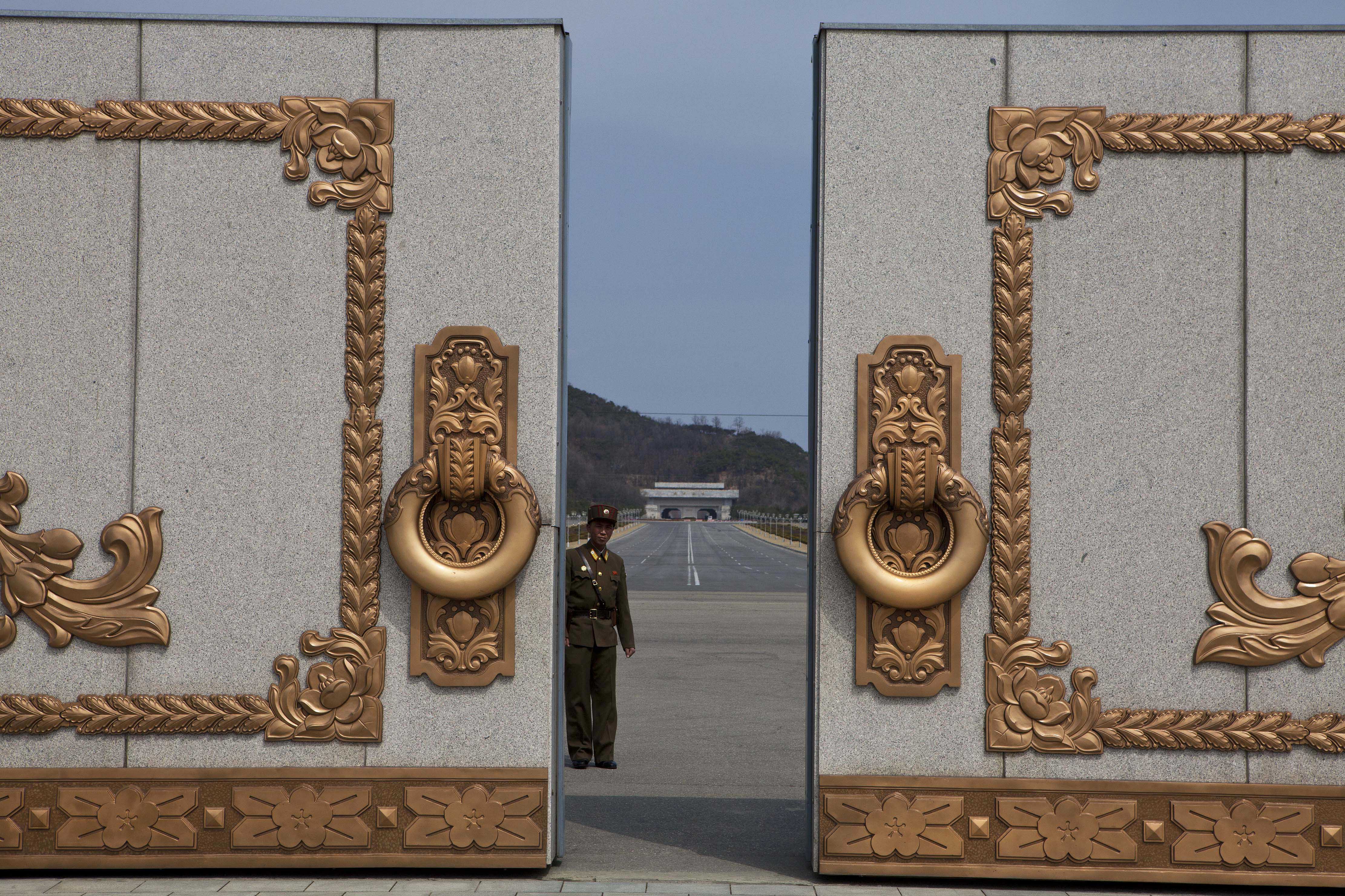
Tensions between the Koreas increased in 2010. South Korea accused the North of sinking one of its warships with a torpedo in March while the ship patrolled the maritime border between the two countries. In November, North Korea fired artillery at an island claimed by South Korea.
Kim Jong-il died on Dec. 17, 2011. His youngest son, Kim Jong-un, was announced as his successor.
North Korea again raised international concerns in December 2012, when it launched a rocket that put a satellite in orbit. Many international observers suspected that the event was a test of the country’s ability to launch missiles capable of carrying nuclear warheads.

International concerns remained high after North Korea conducted another nuclear test in February 2013. Following the test, international tensions rose to their highest levels in years. The North Korean government issued threats against military bases in Japan, South Korea, and the United States. In April, the government announced that it would restart the nuclear reactor it had shut down in 2007.
In late 2014, computer hackers attacked the network of the film company Sony Pictures. The hackers sent threats that they would attack theaters showing the upcoming film The Interview, a comedy about a plot to assassinate Kim Jong-un. The United States Federal Bureau of Investigation claimed to have traced the hack to the North Korean government, which denied the allegations. Sony initially announced that it would cancel the film’s release. In late December, the film was given limited theatrical release and was released online.
In September 2015, North Korea’s government announced that the country had restarted its nuclear program. North Korea continued testing nuclear devices and ballistic missiles in the following years.
In 2016, the North Korean government formed a new State Affairs Commission and declared its chairman to be the nation’s highest living official. As chairman of the new commission, Kim Jong-un remained the nation’s leader.
The 2018 Winter Olympic Games were held in Pyeongchang, South Korea. North and South Korean athletes marched into the stadium together during the opening ceremony under a flag depicting a unified Korean peninsula. Athletes from North and South Korea also played on a single women’s hockey team.
In April 2018, South Korean President Moon Jae-in and North Korean leader Kim Jong-un met at Panmunjom, in the Demilitarized Zone, for the first of several summits between them that year. At the meeting, the two leaders pledged to remove nuclear weapons from the Korean Peninsula and to work toward reaching a formal peace agreement to officially end the Korean War.

In June, Kim and United States President Donald J. Trump held a summit meeting in Singapore. At the meeting, the two leaders signed a document that called for the complete denuclearization of the Korean Peninsula. At a second meeting in February 2019, negotiations centered around Kim’s hopes of having the international economic sanctions against North Korea lifted and Trump’s desire to end North Korea’s nuclear weapons program, but no agreement was reached.
North Korea soon resumed its missile testing, and tension rose again. During 2019, Kim also met in separate summits with President Xi Jinping of China and with President Vladimir Putin of Russia. In 2022, North Korea tested over 90 cruise and ballistic missiles and proclaimed itself a nuclear weapons state. Kim described this declaration as ruling out any possibility that North Korea would give up its nuclear weapons.
